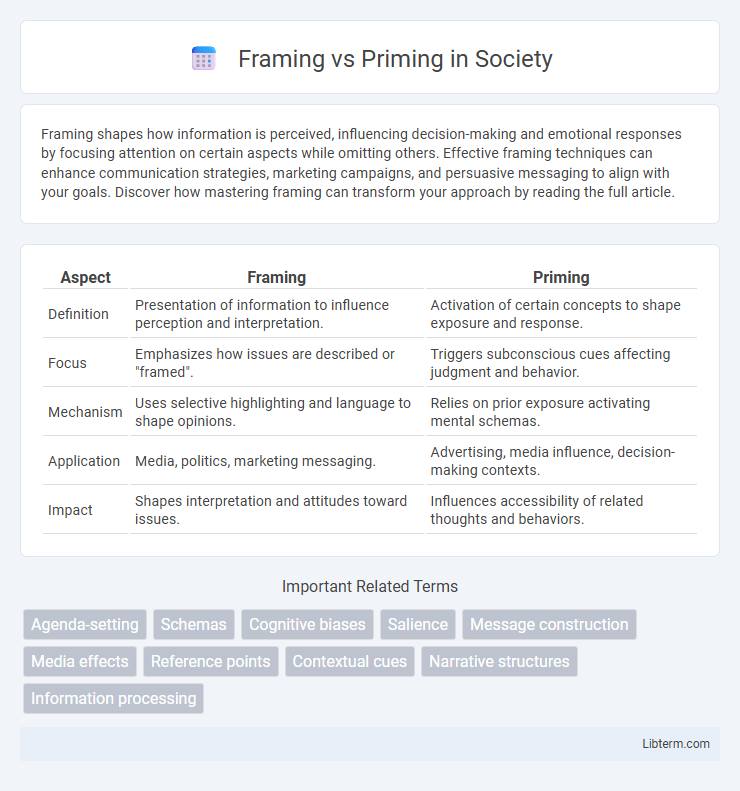Framing shapes how information is perceived, influencing decision-making and emotional responses by focusing attention on certain aspects while omitting others. Effective framing techniques can enhance communication strategies, marketing campaigns, and persuasive messaging to align with your goals. Discover how mastering framing can transform your approach by reading the full article.
Table of Comparison
| Aspect | Framing | Priming |
|---|---|---|
| Definition | Presentation of information to influence perception and interpretation. | Activation of certain concepts to shape exposure and response. |
| Focus | Emphasizes how issues are described or "framed". | Triggers subconscious cues affecting judgment and behavior. |
| Mechanism | Uses selective highlighting and language to shape opinions. | Relies on prior exposure activating mental schemas. |
| Application | Media, politics, marketing messaging. | Advertising, media influence, decision-making contexts. |
| Impact | Shapes interpretation and attitudes toward issues. | Influences accessibility of related thoughts and behaviors. |
Understanding Framing and Priming
Framing involves presenting information in a way that influences perception by emphasizing certain aspects over others, shaping how individuals interpret and respond to the message. Priming activates specific associations in memory, affecting subsequent thoughts and behaviors without conscious awareness. Both cognitive processes play critical roles in decision-making, communication strategies, and media influence by subtly guiding interpretation and judgment.
Key Differences Between Framing and Priming
Framing shapes perception by presenting information within a specific context or angle, influencing how people interpret and evaluate issues. Priming activates related concepts or associations beforehand, subtly affecting responses and decision-making without altering the message content. Key differences lie in framing's emphasis on message construction for interpretation and priming's role in triggering subconscious cognitive pathways.
The Psychological Foundations
Framing and priming both stem from cognitive psychology, with framing based on how the presentation of information influences decision-making by highlighting certain aspects over others. Priming operates through subconscious activation of related concepts in memory, which shapes perceptions and reactions without overt awareness. These mechanisms exploit mental shortcuts to guide judgments, demonstrating the mind's susceptibility to contextual and associative cues.
How Framing Influences Perception
Framing influences perception by shaping the context in which information is presented, altering how individuals interpret and respond to that information. By emphasizing certain aspects over others, framing directs attention and affects emotional reactions, leading to different judgments and decisions. Studies in cognitive psychology demonstrate that positive or negative framing can significantly impact risk assessment and consumer behavior.
The Impact of Priming on Behavior
Priming influences behavior by exposing individuals to specific stimuli that trigger associated memories and emotions, shaping their responses subconsciously. Behavioral changes occur as primed concepts increase cognitive accessibility, affecting decisions, judgments, and actions without conscious awareness. Studies show that priming can modify social behavior, consumer choices, and even performance, highlighting its powerful role in guiding human conduct.
Real-World Examples of Framing
Framing influences public perception by presenting information in specific contexts, such as media coverage of climate change highlighting economic risks versus environmental damage. Political campaigns often use framing to shape voter opinions by emphasizing issues like national security or healthcare costs. In advertising, products are framed either as luxury items or affordable necessities, significantly affecting consumer behavior and decision-making.
Real-World Examples of Priming
Priming influences behavior and decision-making through subtle cues, such as a study where participants exposed to words related to aging walked slower afterward. In marketing, visual primes like luxury brand logos can trigger consumers to spend more impulsively. Political campaigns use priming by repeating specific phrases to shape voter perceptions and attitudes without overt persuasion.
Applications in Media and Advertising
Framing in media and advertising shapes audience perception by highlighting specific aspects of a story or product, influencing how information is interpreted and prioritized. Priming activates certain associations in consumers' minds before exposure to the main message, subtly guiding responses and behavior toward brands or social issues. Both techniques impact decision-making processes, with framing altering narrative context and priming affecting subconscious preferences, making them powerful tools for crafting effective marketing campaigns and news coverage.
Implications for Decision-Making
Framing shapes decision-making by influencing how information is presented, often affecting risk perception and choice preferences through positive or negative framing effects. Priming impacts decisions by activating related concepts or schemas unconsciously, which can alter judgments and behavior without explicit awareness. Understanding both framing and priming mechanisms is crucial for developing strategies to mitigate cognitive biases in consumer behavior, policy-making, and organizational decisions.
Strategies to Mitigate Unconscious Influence
Framing and priming influence decision-making by shaping perception through word choice and contextual cues, often operating below conscious awareness. Strategies to mitigate their unconscious impact include promoting critical thinking by encouraging individuals to question initial impressions and presenting multiple viewpoints to reduce bias. Implementing structured decision-making processes and increasing awareness of these cognitive biases further helps in minimizing their subtle, yet powerful, effects on judgments.
Framing Infographic

 libterm.com
libterm.com